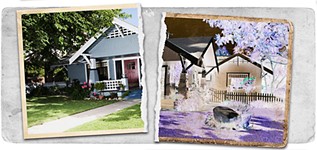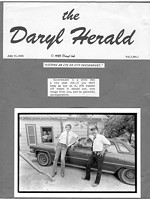Light Rail Debate
Former City Council Member Max Nofziger vs. Current City Council Member Daryl Slusher
By Daryl Slusher, Fri., Nov. 3, 2000

Light Rail: Now --- or Houston Tomorrow
In almost a decade writing for the Chronicle, my priorities were always protecting Austin's environment and working for everyone to have a chance at economic prosperity. Rail is an essential tool in both, and it is troubling that some allies on environmental and social equity efforts are opposed to rail. If that trend continues, rail might not pass. In my view, that would be devastating to the future of Austin.The fact is that Austin is growing much faster than many old-timers like myself would prefer. Those of us in policymaking positions must find ways to steer that growth in the most sustainable manner, while seeking to preserve and enhance this incredible city. It is a very tough challenge.
One of the biggest challenges is transportation. Roads alone cannot do the job. Neither can rail alone. Rail, however, is the only proven alternative that gets cars off the road while providing reliable transportation.
Please indulge in this mental exercise that came to me while waiting to make a right turn onto Lamar. Look around at the traffic now, and then imagine it 25 years from now, with no major alternative to the automobile.
I see crowded streets, cars routinely cutting through neighborhoods, and pressure for massive highway expansions. For example, official projections by highway planners are that without rail, I-35 must be expanded to 10 lanes, plus a reversible High Occupancy Vehicle (HOV) lane. That is almost a doubling in size and would mean taking out businesses, homes, and major institutions. Other suggestions from rail opponents include double-decking MoPac, an outer loop around the entire city -- including across the Edwards Aquifer -- and widening virtually all city arterials.
Without rail, demand for these roads-only solutions might increase dramatically. And the decision-making on highways will lie largely with state highway officials, not local officials or citizens. That includes South Congress, a state highway, which is slated to be an eight-lane divided highway -- a scenario much more likely without rail.
Even those who favor these solutions face a long wait. I-35 and MoPac changes cannot, under state and federal processes, even begin until 2007. Rail can be operating by then.
Some rail opponents, including paid spokesperson Max Nofziger, promote an expanded bus program called the High Performance Plan -- which features no cost estimates and whose author admits is "experimental." Even if this mystery program were successful at getting huge numbers of people to leave their cars for buses, the plan would mean worse congestion due to many more buses in traffic and long waits behind buses as they load during rush hour. Keep in mind that one train has the carrying capacity of 10 buses, and trains have their own tracks.
This brings me to a central dilemma in the campaign and in writing this article. I respect the opinions of most rail opponents, but at the same time the anti-rail effort has been -- to put it nicely -- filled with misinformation. Refuting the misinformation would take several pages, so I'll just address a couple of examples.
Leading opponents maintain that rail is a failure in every city that has it. Yet those systems are packed with riders, and voters keep approving more rail lines. Opponents claim that rail will only get 1% of cars off the road. That figure gives fuzzy math a bad name. It is calculated by comparing rail ridership projections to traffic in three entire counties -- when Capital Metro serves only one-sixth of that area. In other words, to arrive at that conclusion, the anti-rail group ROAD counts every time someone gets on MoPac, or I-35 between Jarrell and San Marcos, when what we're talking about is rush hour in Austin. By that standard, any road or rail project will be in single digits. A more relevant figure is that rail takes one of every 20 cars off I-35 between Round Rock and Slaughter Lane during rush hour.
Top 10 Reasons to Support Rail
1. Rail is the best shot Austin has at reversing air pollution. The majority of air pollution in Austin is caused by gasoline-burning vehicles. Electric-powered rail will provide a proven alternative to the automobile. Results around the nation, including those in Dallas, show that rail gets more people out of their cars than any other alternative.
2. Rail can also be a powerful tool in protecting water quality. The proposed route is entirely through the Desired Development Zone (DDZ), where environmentalists have long tried to direct growth. By providing a new form of transportation in the DDZ, rail can be the most powerful tool yet for preventing sprawl and steering growth where it is most sustainable. At the same time, the city maintains zoning and planning powers to protect existing neighborhoods and businesses.
3. Rail will help families save money. Families that now need two cars could get by with one. Depending on individual situations, one parent could use the train and the other drive to work. Or, the whole family could take the train -- by walking to the train stop or driving to a rail park-and-ride. This saves families money for other needs.
4. Rail will improve the lives of transit-dependent citizens. People without cars could get to jobs at places they can't reach conveniently by bus. This would open new opportunities. Additionally, child care centers will be located at or near rail stations. This would cut down dramatically on the time parents spend getting their children to child care, then getting to work. This would give them more quality time together. Opportunities like this are one of the reasons groups like the Travis County Black Elected Officials, the Hispanic and African-American Chambers of Commerce, and the Black Voters Action Project endorsed rail -- and why former council member Gus Garcia, who has spent much of his life promoting economic justice, is a passionate advocate of rail.
5. Rail can be built with no tax increase. The entire 52-mile system can be built with Capital Metro's existing one-cent sales tax, on a pay-as-you-go basis. These local funds will pay half the total cost, while the federal government is being asked to pay the other half. The Federal Transit Administration has already given Capital Metro's proposal a "recommended" rating. If rail is not approved, approximately one billion in federal transit funds will go to another community.
6. It's not the same old Capital Metro. A big hurdle for rail is Capital Metro's history. When I joined the board in 1997, some argued for immediate rail construction. Although a strong advocate of rail, I said the agency needed to put its financial and management house in order first. We have done so. We got a performance audit from then-Texas comptroller John Sharp and used it as a road map for reform. The agency is under almost entirely new management. The FTA's recent review of Metro operations gave Capital Metro top marks in all areas. Most importantly, bus ridership is increasing at more than double the rate of population growth while the percentage of tax funds going to bus operations has decreased each year of this board's tenure.
7. Rail will help get traffic off neighborhood streets and help keep freeways from being built through neighborhoods. Rail systems around the nation have helped clear crowded major arterials and moved traffic cutting through residential neighborhoods back onto arterials. Failure to build rail will result in much heavier demand for road expansions through and near neighborhoods.
8. Local businesses can be protected during construction, and rail will enhance access to local businesses after it opens. Many business owners along rail routes fear that rail threatens their existence both during construction and after it opens. This is a legitimate concern, but not one that has proven to be true with other rail projects.
For example, at Capital Metro we brought in representatives of a company that successfully completed rail through Fisherman's Wharf in San Francisco. Many business owners there were just as opposed to rail in San Francisco as South Congress merchants are to rail in Austin. After successful construction, however, the merchants association presented the company with an award for its efforts. Today, the area thrives even more with rail. There are many other such examples.
Much is a matter of attitude. As Eddie Wilson of Armadillo and Threadgill's fame -- a former rail opponent -- suggests, the construction can be made into a party, by surrounding it with neon lights and local art. In this way more attention than ever is called to areas like South Congress, bringing in people who don't even know these eclectic areas exist.
9. It works in other cities. Denver, Portland, San Diego, Salt Lake City, St. Louis, and Washington, D.C., all have successful systems. The Dallas system has exceeded ridership projection by some 40%. Voters there recently approved bonds for an extension of the system, with 77% in favor.
10. So Austin doesn't become Houston. It is not an exaggeration to say we face a choice between an Austin or Houston future. Houston is the model of congestion relief held up by leading rail opponents. Decades of relying on cars alone has left Houston battling Los Angeles for the titles of most polluted and most congested city in the nation. And now, even Houston is building rail. Let's not wait until it is too late.
For more information, readers can go to www.light railnow.org, where I run rail through my boondoggle indicators. ![]()
Got something to say on the subject? Send a letter to the editor.








